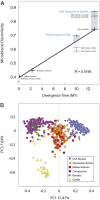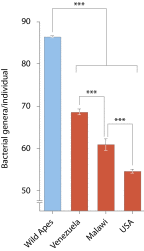Rapid changes in the gut microbiome during human evolution
- PMID: 25368157
- PMCID: PMC4246287
- DOI: 10.1073/pnas.1419136111
Rapid changes in the gut microbiome during human evolution
Abstract
Humans are ecosystems containing trillions of microorganisms, but the evolutionary history of this microbiome is obscured by a lack of knowledge about microbiomes of African apes. We sequenced the gut communities of hundreds of chimpanzees, bonobos, and gorillas and developed a phylogenetic approach to reconstruct how present-day human microbiomes have diverged from those of ancestral populations. Compositional change in the microbiome was slow and clock-like during African ape diversification, but human microbiomes have deviated from the ancestral state at an accelerated rate. Relative to the microbiomes of wild apes, human microbiomes have lost ancestral microbial diversity while becoming specialized for animal-based diets. Individual wild apes cultivate more phyla, classes, orders, families, genera, and species of bacteria than do individual humans across a range of societies. These results indicate that humanity has experienced a depletion of the gut flora since diverging from Pan.
Keywords: Gorilla; Pan; coevolution; gastrointestinal tract; microbiota.
Conflict of interest statement
The authors declare no conflict of interest.
Figures



References
-
- Spor A, Koren O, Ley R. Unravelling the effects of the environment and host genotype on the gut microbiome. Nat Rev Microbiol. 2011;9(4):279–290. - PubMed
Publication types
MeSH terms
Associated data
Grants and funding
LinkOut - more resources
Full Text Sources
Other Literature Sources
Molecular Biology Databases
Research Materials
Miscellaneous

